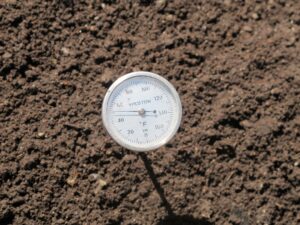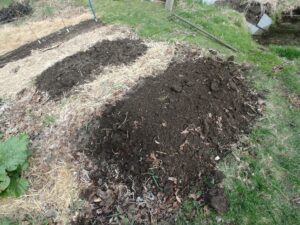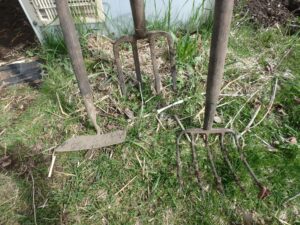Is It Time to Plant Yet?
Posted on Sunday, May 17, 2020 · Leave a Comment
Some folks in my part of New England plant seeds in the ground on Mother’s Day and seedlings on Memorial Day weekend. Not me. Others use Mother Nature’s clues: plant spinach when the forsythia blooms, potatoes when the leaves of an oak are the size of a mouse’s ear. That sounds good, but who really knows how big a mouse’s ear is?
I start a lot of seedlings indoors, some as early as February, and (like any good mother) I am protective of my young. I only put out plants or plant seeds when I am sure that they will succeed. So I plant my tomatoes and other heat-loving plants in June, generally after the tenth of the month. Those heat lovers include tomatoes, peppers, eggplants and all the vine crops – cukes, squash, pumpkins. Even broccoli, which is frost-hardy in the fall, does not go in early. It is much more sensitive now to frost.

A soil thermometer will tell you if it’s warm enough to plant
What I have found is that soil temperature is very important to success. Yes, you can plant peas or spinach “as soon as the soil can be worked” (as described on the packages), but those seeds won’t germinate and grow if the soil is in the forties. And the seeds can rot. Seeds have triggers that tell them when to grow. That’s why starting seedlings indoors on heat mats speeds things up. The seeds think it is summer when the soil is 72 degrees. Generally the soil must be 60 degrees to get a good quick germination.
So how do you determine the soil temperature? Buy a thermometer designed for it. Generally these thermometers look like a meat thermometer. The probe is 6 inches or so long. Push 3 inches into the soil and wait for a reading. I gather digital ones now exist, too.
What can you do to warm your soil up? If you’re in hurry, rake off winter mulch and expose the soil to the sun. Do that now. Then you can cover the soil with a plastic sheet, either clear or black. I’ve found clear plastic is best. Sun heats the soil directly and the plastic holds in the heat (but be sure to seal the edges of the sheet with soil to keep the heat in). On a sunny afternoon in the sixties, the temperature under the plastic can exceed 100 degrees.

Raised beds warm up quicker than flat beds in spring
Another advantage of warming the soil with plastic for a few days is this: you can cook and kill annual weeds. They are sensitive to high temperatures when they first come up. Dandelions or witch grass, which are perennial, have root systems you know and hate. A few hot days under plastic will only make them giggle.
I’m not keen on rototilling. Yes, it will make your garden look very pretty, not a weed in sight. But for some weeds, each scrap of weed will produce a new plant. Chop up some witch grass and watch it take off! And if you get the top six inches of your garden warmed up, and then rototill, all that cold soil below will cool down the rest.
I like to think of the all the living things in the soil as my friends. Earthworms, beneficial fungi and bacteria, little arthropods? All of these help to break down organic matter and make it available in a form useable by my plants. And I think of the layers of soil as the floors of an apartment building. Some people like the penthouse, others want a ground floor room. When you rototill, you jumble up the order of things and put the penthouse in the basement.

Hoe, garden fork, and potato fork are 3 useful tools for making garden beds
So how do I prepare my garden? I create wide, raised beds using only hand tools. I have a 5-tined potato fork or hoe that has been in my family for 50 years or more. I use it to loosen the soil and shape the beds. But you can use an ordinary garden fork and a hoe to accomplish the same. I pull up soil from the walkways to raise the level of the beds and shape them. I try to disturb the soil as little as possible.
Most of my raised beds are between 24 and 36 inches wide and are 6 to 8 inches above the walkways, which I keep narrow, so as to not waste space. Generally they have no wood sides, though I do use planks to contain the soil in a few. I like a wood-sided raised bed for growing carrots, as they need fluffy soil with no rocks in order to get to be 12 inches long, my goal each year. With wood-sided beds you can build whatever soil you want by mixing in the ingredients.
Before putting your plants in the ground, harden them off. Whether you bought your tomatoes or started them indoors yourself, they can get sunburned or wind-burned if they go outside to a full day’s sun without some preparation. Start with 3 hours of morning sun, then add some afternoon sun. Watch for signs of stress. After 5 to 7 days of protection from too much wind and sun, they will be ready for planting
I like to do some cold season plantings, and have a cold frame to get a few things growing in April. But I also know that my tomatoes planted in mid-June will catch up with any planted on Memorial Day weekend. Each of us has to figure out what works best.





